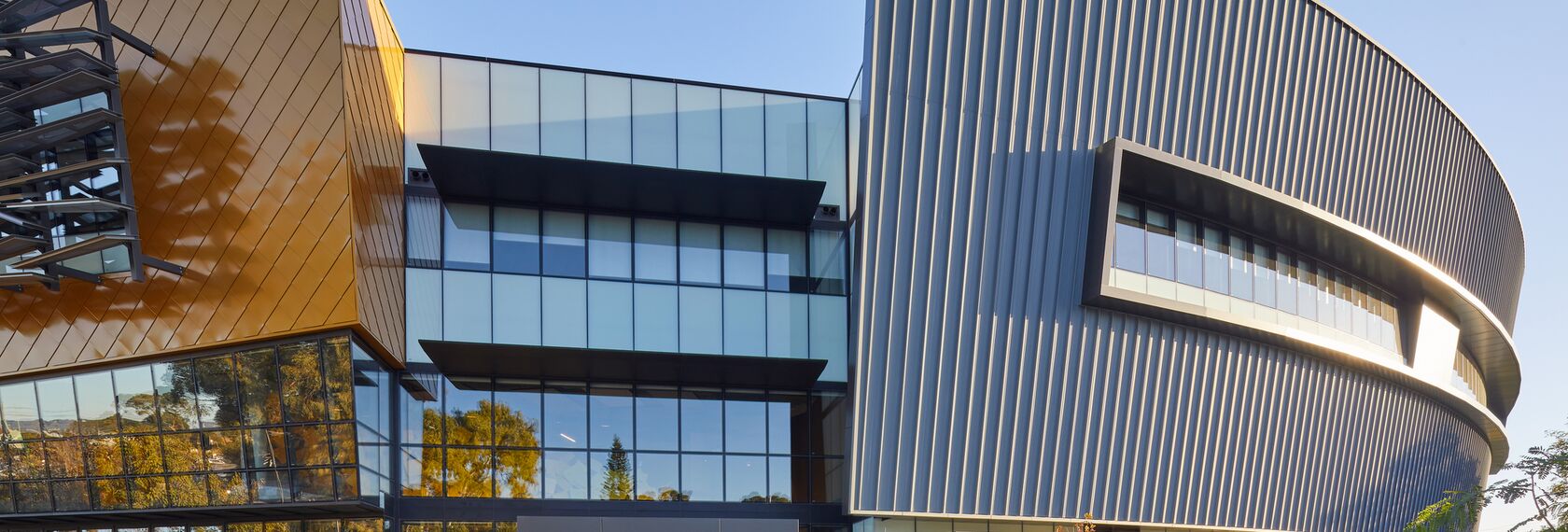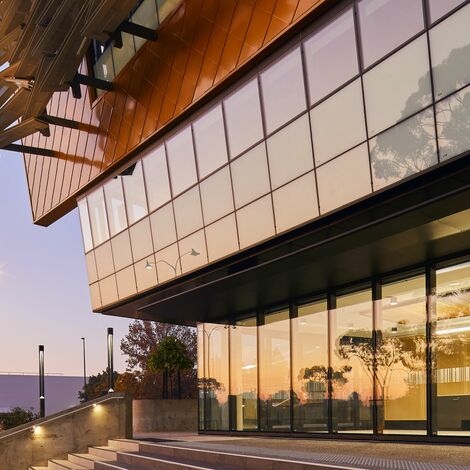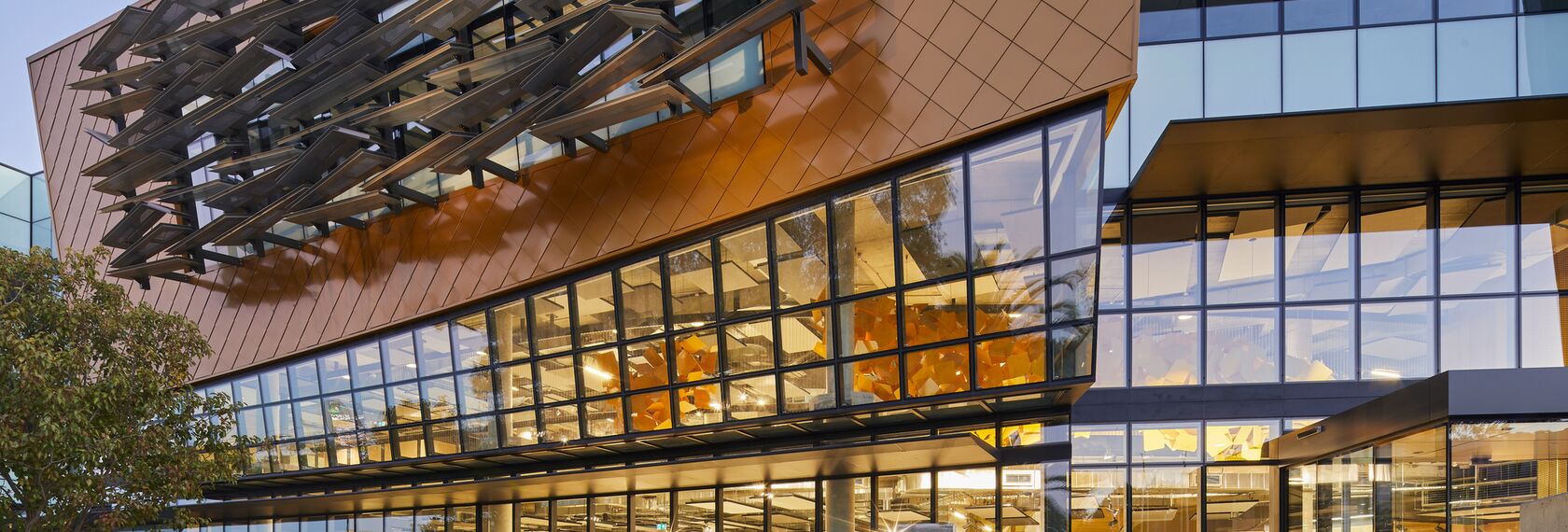- Bollig Design Group
Belmont Hub
Australia's Bollig Design Group (BDG) recently unveiled the completed Belmont Hub, a multi-purpose and cross-generational community centre located in the Belmont district of Perth, Western Australia. The $41.5 million (AUD) project - the largest in the history of the City of Belmont to date - is positioned as an integrated community and cultural hub of learning, gathering, reflecting, and socializing that sets a new regional and national benchmark in community service delivery both now and into the future.
The building comprises a two-level library, digital hub, and recording studio, seniors’ center, and state of the art museum as its primary functions, also incorporating adjunct dining, childcare, green space, and a range of office spaces for community organizations and nonprofits. The project was commissioned by the Belmont City Council and financed through a combination of federal and municipal funding, grants, and outreach. Council undertook extensive community consultation in developing the project brief which was then passed to BDG who were tasked with the full scope of project management across each stage of the development, from initial concept and design through to construction and delivery. BDG in turn partnered with PACT Construction to realize the built structure and collaborate on the construction challenges and solutions posed by the design, the municipal requirements, and leading-edge industry best practices.

In addition to the functional components identified in the City's brief, logistical and sustainability requirements also informed the design concept. The brief called for the use of CPTED principles (Crime Prevention Through Environmental Design) to ensure safety and trust of users was inherent across the entire scope of the project, and also required the building to pursue a 6 star Green Star rating, at minimum guaranteeing 5 stars. Bounded on three sides by busy roads and on the fourth by an existing office building, the site envelope only allowed a 3500 sqm footprint. This necessitated a multi-level solution, but height had to be mitigated in congruence with CPTED principles. Combined, these constraints meant that the design had to respond to a range of factors - the existing site parameters and contours of both natural and built elements, environmental metrics, and accessibility, sustainability, and community needs. To address these challenges, BDG anchored the design concept around a theme of visual transparency.
The existing office building on site featured a curved frontage, which BDG used as a motif throughout the new design. The new building features a curved facade curtain wall that mirrors the older building and creates a funnel-style entrance between the two building spaces, which are now joined by a landscaped open-air plaza (formerly a carpark - the parking bay is now relocated underground beneath the new structure). The plaza centers around two large fig trees which were already on the site and needed to be preserved as per community wishes. The figs were interwoven into the design and used as an opportunity to bring the landscape into the building, the new contours wrapped around them. The plaza is community landscaped and includes spaces for passive recreation as well as a community run demonstration kitchen.

The entrance to the building functions as its active edge at the pedestrian level and seeks to transition and transport visitors seamlessly between the indoors and outside. The physical permeability is complemented by visual permeability via the extensive use of glass. From the ground floor, users can access the interconnected functions of the library, cafe, museum, and seniors’ centre. Spaces are open plans, allowing flexibility for future adaptation to new uses and emphasizing transparency and interconnection. The atmosphere of the space is intended to be friendly, unpretentious, and encouraging of movement and exploration throughout the space. Interior building spaces are laid out and layered vertically and horizontally, facilitating interaction both between generations and between various community members and uses, reflecting the free flow dynamic that defines a community.
Transparency is further articulated via spatial interventions throughout the space. A complex glazing system was employed to allow external visitors to view indoors spaces and reciprocally allowing internal visitors to enjoy the natural and sculptural landscapes and surrounds beyond the built perimeter. Contrasting façade elements including aluminium shingles, composite wood cladding, and both vertical and custom-angled sunshades used on different sides to create a layered, textured building envelope. A feature skylight supported by a 20-tonne structural steel frame tops a central atrium space comprising a glass lift and 'floating' staircase with no supporting columns or beams. The overall effect of the atrium is of a void element running down the central spine of the structure and uniting the functions into a cohesive, holistic articulation. Larger structural concrete and steel beams and mechanical elements are intentionally left exposed to visitor view. BDG explain:
"The external design was heavily influenced by the need for a 5 star Green Star outcome on a building that wanted a clear glass. The use of inclined facades, extensive sun shading, highly insulated cladding panels were all a response to the sustainability and lifecycle cost requirements. The client also had in the brief that wanted a building that was an exemplar demonstrating the Council’s commitment to the community and instantly recognizable as a landmark for the City."
Sustainability principles are inherent through the design. Secondary consultants provided collaboration on a range of bespoke solutions to ensure maximum environmental and sustainability efficiency. Photovoltaics harnessing 100kw of solar power was implemented to drive heating and cooling functions and generate solar-boosted hot water. Low energy LED bulbs were installed throughout, enhanced by dimmer and motion sensor smart functions to prioritize usage of natural daylight. Low water use sanitaryware was installed along with on-site rain collection and storage. Recycled and upcycled internal components such as carpet, ceiling panels, and workstations were employed wherever possible and polished concrete floors were chosen to both lower maintenance costs over time and to integrate with the high-performing ceiling and wall acoustic design. An intelligent BMS monitors and controls these and other functions, including ventilation and expiration technologies.
Although visually striking, the design's focus on transparency called for the façade to include a curved curtain wall, a technically complicated proposition. To realize this, Bollig partnered with aluminium experts Reynaers, who offer bespoke and custom solutions for glazing challenges. Senior Architect and Managing Director of the project Edwin Bollig explains:

“The entire glazed façade was customized to suit the unique design, requiring a high degree of coordination and cooperation between the architect, façade engineers and fabricators.”
A key element in realizing the ambitious glazing concept was Reynaers Aluminium ConceptWall 60-SC solution. The number 60 refers to the system's 60mm visible width of indoor joinery, and the SC designation denotes 'structurally clamped', the system relying on innovative, slim profile aluminium clamps strategically located to hold heavy glass panes in place. Reynaers Aluminium developed this solution specifically to cater to designs such as BDG's that require heavier panes. The ConceptWall solution uses a modular system design that facilitates intelligently reinforced profiles capable of supporting weights of up to 450kg. This allows for a robust construction that is able to answer the specific safety and sustainability needs of curved design without sacrificing design freedom.
From a sustainability perspective, the ConceptWall60 system scores highly across a range of comfort metrics, with high acoustic insulation and excellent water and wind tightness and impact resistance. In addition, the system offers superior thermal insulation, allowing integration with the overall philosophy of energy conservation inherent throughout the project. Project managers and clients are often reticent to use bespoke solutions to construction challenges as they tend to be higher budget relative to more typically used materials or processes. BDG explain that not only did this project come in on budget, but there are additional cost metrics that should be considered in forward looking projects such as this:
"The financial success of this building can be assessed based upon the dollar per square meter cost ($3375/m2 including fit-out) which is exceptional for the quality achieved. However, the real financial success is the contribution to the Belmont community that accesses the building and the huge variety of services in the building. The flow-on effects socially and financially will last for the next 50 years plus."
The Belmont Hub stands as a collaborative project designed both with the community and for the community, culminating in a cutting-edge, landmark building that showcases the structural and functional aesthetics of geometrical design. Visually and texturally contrasting materials harmonize with bespoke structural and engineering solutions to create a thriving gathering space for learning and socializing which is currently seeing 4000 visitations a week and is designed to continue to accommodate and adapt to the changing needs of its community many years into the future.
Involved stakeholders
Architect
- Bollig Design Group
Fabricator
- Com-AL Windows
Photographer
- Douglas Black
Other stakeholder
- PACT Construction (General contractors)
- City of Belmont (Investors)







